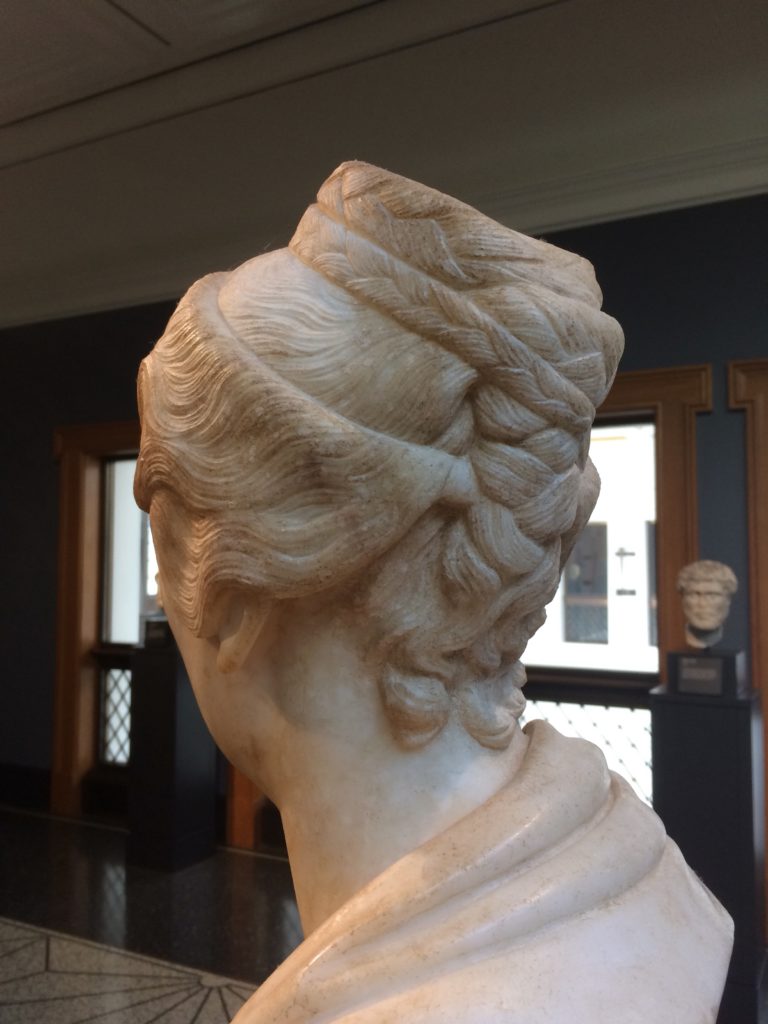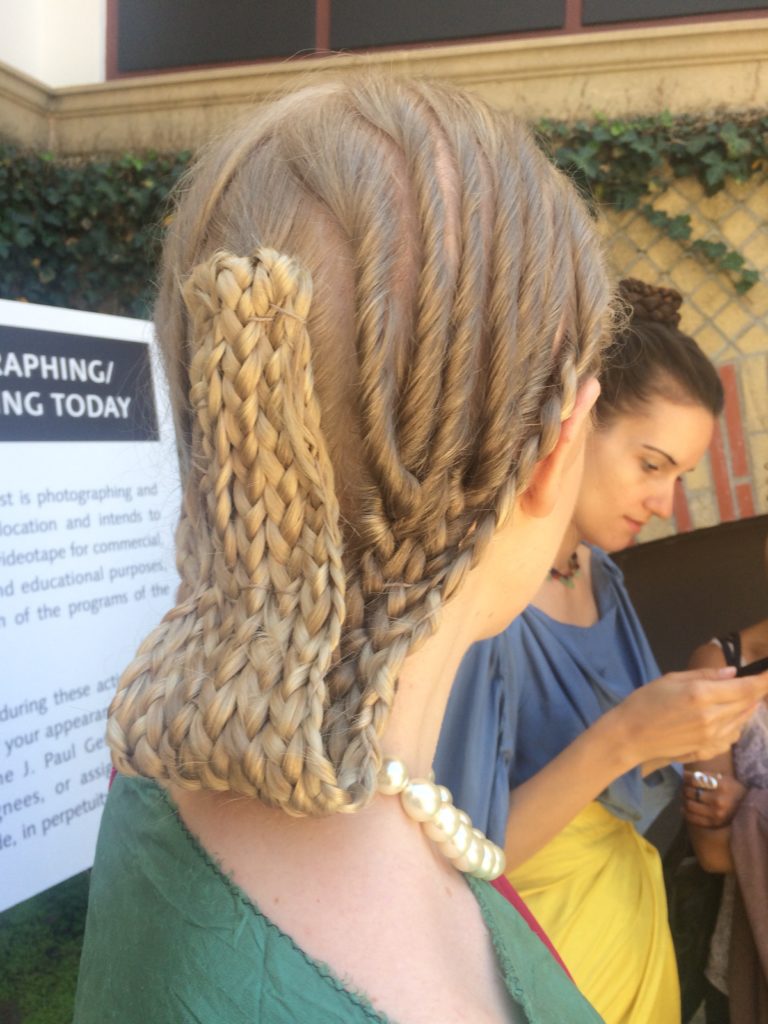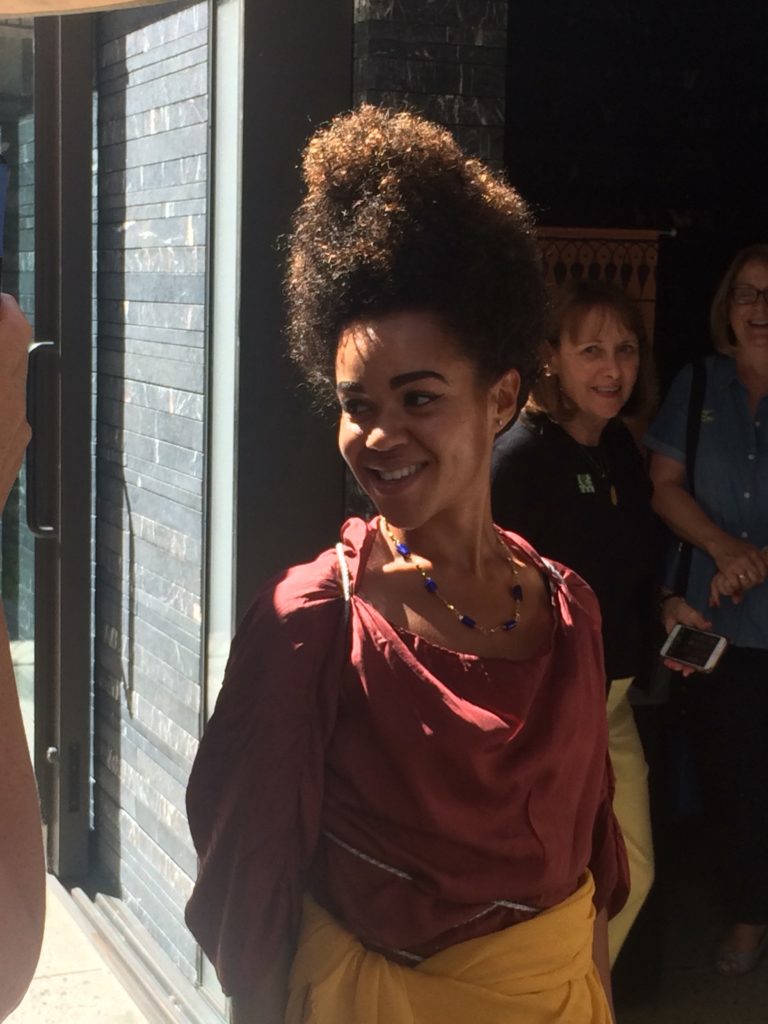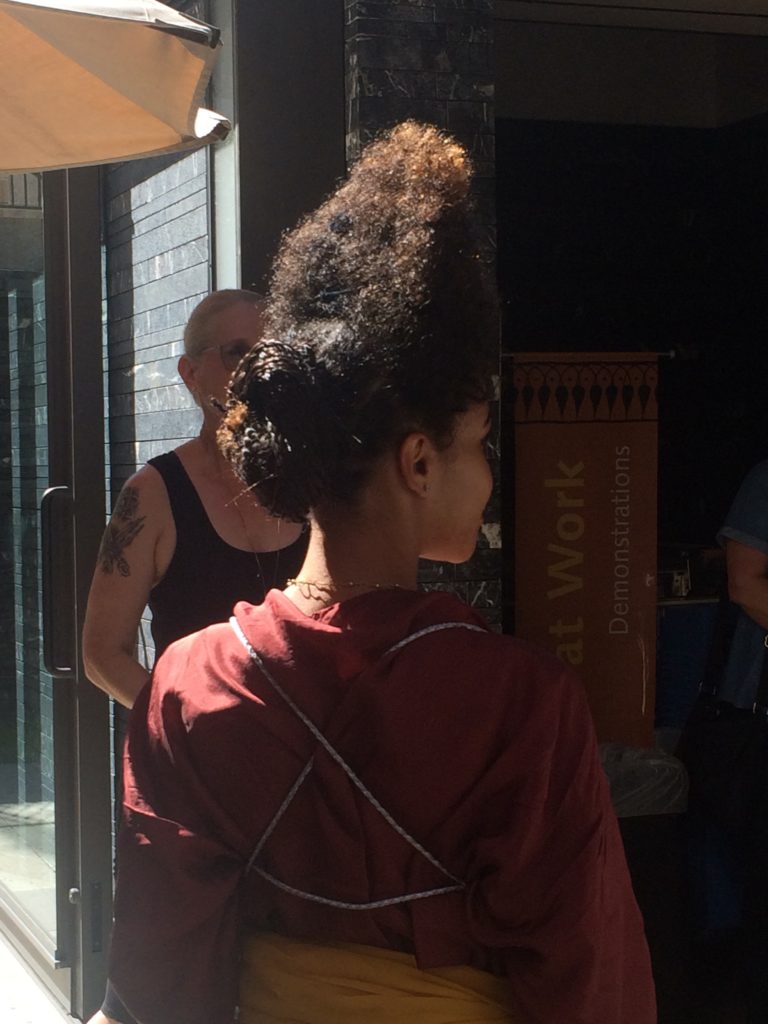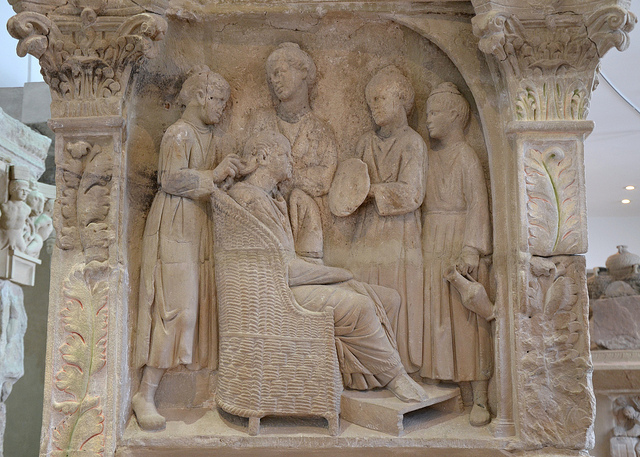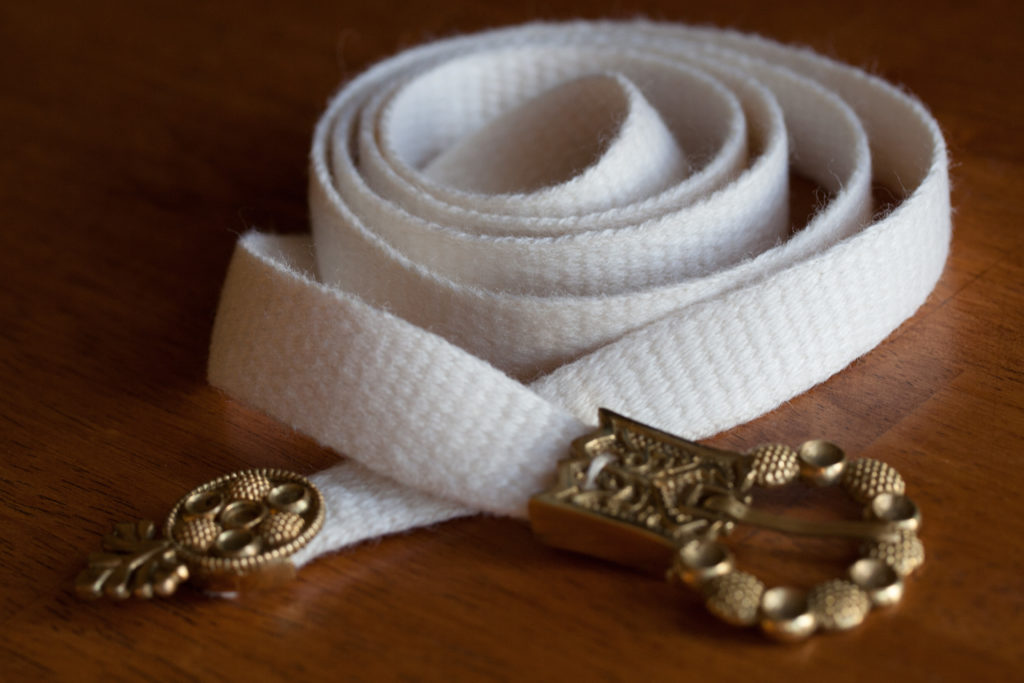This weekend Paul and I got to be part of an amazing event, Perfectly Period Feast – Burgundy. Through these words I will try to tell the story as I experienced it, but they will only scratch the surface of all of the different elements that came together to make this the most immersive SCA experience I’ve had.
What is a “Perfectly Period Feast”? It’s an entire day attempting to replicate the experience of a grand meal from a specific historical place and time. This event was the feast day of St. Martin of Tours in a pretentious merchant household in the Burgundian Netherlands in 1450-1468.

Livre des Conquestes et faits d’Alexandre. Mid-15th century. Petit Palais, Paris. LDUT456.
So what does it mean to try to replicate the experience of a historical meal from a specific place and time?
- All of the recipes for the food in the meal were sourced from manuscripts from that time period and location.
- All of the table linens, place settings, and serving implements were selected based on historical records of what was used in that time and place.
- The room layout and everything on the tables was arranged based on paintings from the era.
- The furniture was selected based on extant items and paintings from that time and place.
- The room was decorated based on evidence from paintings, and no artificial lighting was used.
- There was a hierarchical cast of servers, each with specific duties based on historical instructional manuals.
- Those serving manuals also dictated exactly how and when the food was delivered and removed from the tables.
- The musical entertainment was based on songs and dances from that time and place.
- The guests were instructed in appropriate table manners and how to interact with the servers.
- Guests were encouraged (but not required) to dress in clothing appropriate to that place and time.
- The after-meal entertainment was appropriate to the place and time. For this event, it was a pas d’armes, a popular tournament style from this era which might have been held in conjunction with a feast day.
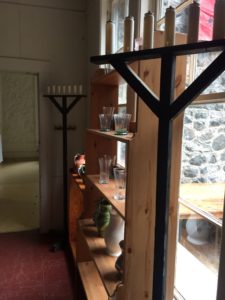
Dishes waiting before setup. Pieces were custom made or modified commercial ones.
There are a lot of different elements that went in to making this event happen beyond all of the culinary aspects of a “normal” feast: casting eating and serving spoons; making historical tables and seating; sewing appropriate napkins for every guest; identifying and practicing appropriate dances; recruiting and training servers in their historical roles. A Perfectly Period Feast (PPF) is a massive undertaking that takes years of research and preparation to pull off. This is the fourth such event (each in a different time and place) that the group hosting this event has run, so they’ve figured out how to seamlessly incorporate so many different aspects.
A big part of the preparation for this event was classes at a variety of events over several years, building both interest and the elements needed for the event. In March 2014, Paul and I attended West Coast Culinary Symposium where Paul took a class on dining etiquette in the 15th century. That class was taught by Mistress Crystal of the Westermark and Sir Geoffrey Mathias, two members of the West Kingdom’s Perfectly Period Feast project and the hosts of this event. That class got us both interested, we talked more with the core group at West Coast Culinary Symposium in 2015, and in November 2015 I went up to the West’s Collegium for a full day of classes on all things PPF Burgundy. I learned about clothing, material culture, dance, carving techniques, music, and more. When I came home, I told Paul “I’ve thrown you under a bus, but I think you’ll like it there” because I’d volunteered him as a possible server.
Fast forward two years, and this event we’d been envisioning was here. Our clothing was done enough to wear, but I was frantically sewing final details while Paul drove us to the event on Friday. Unsure of how much historical chatter there would be, I reviewed some of the history of Philip the Good’s reign I’d read over the summer. What would it actually be like? Would the effort we put in to preparing for the event be enough to support the vision and huge amount of work put in by the organizers?
The event was held at the Bothin Youth Center, a beautiful Girl Scout camp in the woods of Marin county. The site was open Friday afternoon through midday Sunday, but only Saturday was a period day. The other two were needed for final preparations and cleanup. We arrived in time for the pot luck on Friday evening, were greeted by friends, and dropped off our belongings in our bunk room on the second floor of the Stone House.
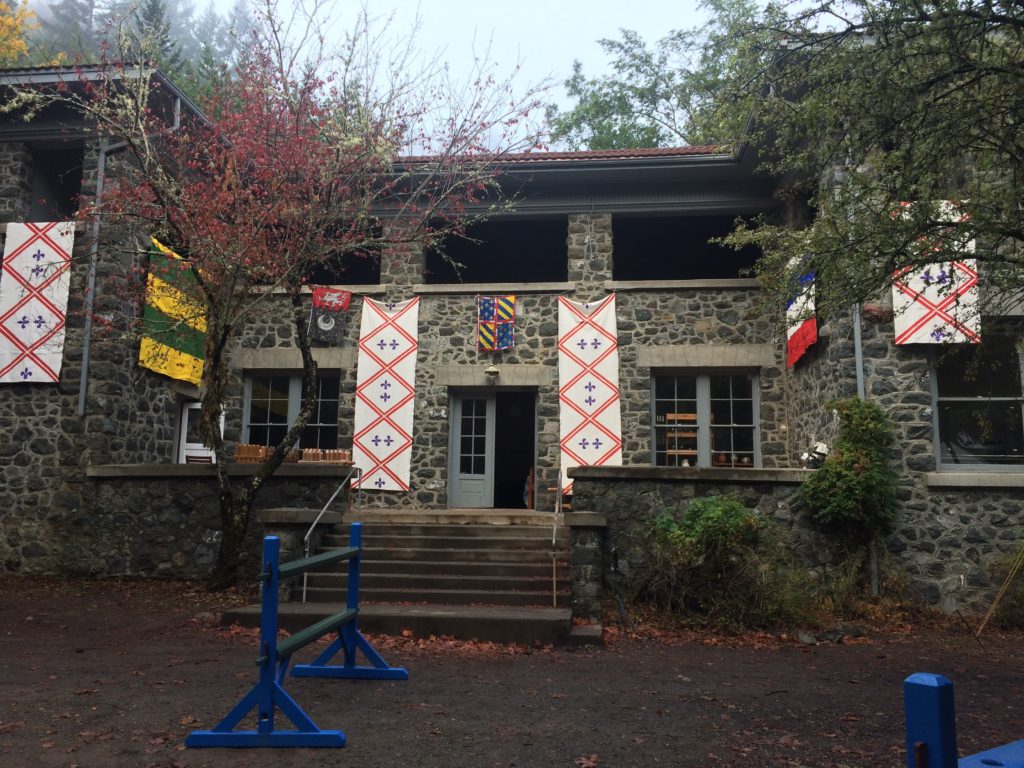
Stone House, dressed up for the feast.
Friday evening Crystal gave a quick refresher course for the guests on dining etiquette: wash your hands and scrub under your fingernails before you come in; don’t put your elbows on the table; napkin goes over your shoulder; eat with your spoon or your fingers; pick up food only with your first & second finger and thumb; wipe your fingers often on your napkin; always wipe your mouth before you take a drink; ask your server if you want more food or drink. It sounded like a lot to remember, but it was clear we’d all do our best to remember.
Master Vyncent atte Wodegate, the marshal of the hall, gave the serving staff last-minute instructions on their individual duties, the schedule of the meal, and the proper technique for a historically appropriate bow. He was kind enough to let interested guests listen in, so I had an idea of what was going to happen the next day. I was thankful for that since I would have a couple of small roles to play in the festivities. Paul had a much bigger job as the carver for the master of the house.
Saturday morning, we enjoyed a light breakfast and then all of the guests focused on getting dressed while the servers worked to finish preparing the feast hall for our arrival. The hall looked empty, but it would soon be filled with all of the diners and servers.

Empty feast hall early Saturday morning before final setup.
Seats were assigned by precedence of the party within three ticket tiers. An actual historical feast would have been more strict on precedence, but since the tickets cost differing amounts they only did ordering within each tier. The three tiers were “high/flanking tables”, “messes”, and “sideboard”. The high/flanking tables (left in image above) had diners seated on one side of narrow tables and a few special dishes. The high table also had additional servers and service rituals. The messes (right in image above) had diners seated on both sides of normal tables. The sideboard did not have seats in the hall. They had food from a buffet table and ate and mingled on the porch outside. There were 18 high/flanking table diners, 24 diners at the messes tables, and 24 diners eating from the sideboard. There were also 31 staff positions, including both the serving staff in the hall and the kitchen staff.
I managed to snag a high/flanking table ticket by submitting my pre-registration about a minute after it opened. The event organizers also chose to bump up the handful of us who traveled from different kingdoms to the top of our tiers. That meant I ended up sitting at the top of one of the flanking tables, right where it became the high table. I was seated between two lovely ladies, Duchess Mary Grace of Gatland (from An Tir) and Countess Eliška z Jihlavy (from the West). In the panorama above, I was seated at the corner of the U on the left side of the image. If you look closely, you can see a red cushion on the chair just past the bench — that was my seat. I had a fantastic view of the extra service happening at the head table, got to interact with the main servers, and got to eat all of the special dishes. It was better than I had hoped for when I learned I’d snared a high/flanking table ticket.
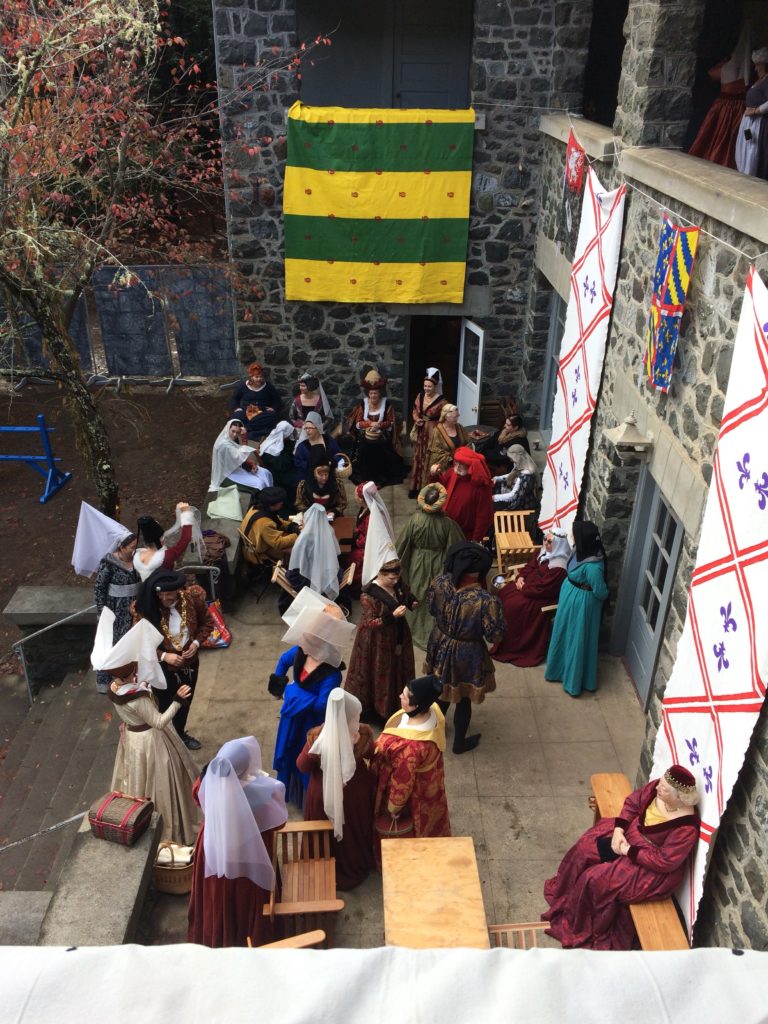
Guests mingling on the porch before the meal.
As the time for the meal approached, the guests were all mingling on the porch and the balcony. We were chatting, dancing, and playing games. Since everyone looked like they had been transplanted from the same general time and place, it was easy to let the modern world slip away and accept the idea that we were at a medieval manor house.
The meal started with hand washing. Your hands were already supposed to be clean but the ritual washing was to prove that they were. For time reasons, most of us did the hand washing out on the porch before we came into the hall. The high table got to do the ritual in front of everyone. One server held a basin while another poured rose-scented water over your hands. For the high table ritual, the person seated below you in precedence held the towel for you to dry your hands.
After the hand washing, the servers removed the piece of fine linen covering the place settings on the high table and the almoner led us in grace (in Latin) before we were seated. The marshal of the hall presented the nef, a beautiful decorative vessel for storing salt. Then the servers brought out round loaves of bread and cut them into pieces we’d use later as implements to help us pick up food.
Then the food began. Mistress Flidais ni Eitigen and her crew did an amazing job producing a seemingly endless stream of tasty things. I knew there were going to be many, many dishes, so I limited myself to only a small amount of each one in the hope that I’d be hungry enough to try everything. I was mostly successful, only skipping one dish. Here’s what I was served. I think. This is a combination of the preliminary menu and my memory, but I’m pretty sure I have a few of the dishes out of order.
- Bread and butter
- Red and green grapes
- Sausages After Killing a Pig (pork sausages seasoned with fennel and spices)
- Capon and Herbs and Shanks of Beef (chicken and beef cooked in spiced and herbed broth)
- Barbe Robert (onion and mustard sauce)
- English puree (peas, onions, and herbs)
- Norse Pies (chicken hand pies with pine nuts, currants, and cheese)
- Broth (chicken and beef broth from the Capon and Herbs and Shanks of Beef)
- Vinaigrette (pork and beef with onions in a spiced wine and vinegar sauce)
- Garden cress with almond (cooked leafy greens in almond milk)
- Cominee (chicken in a ginger, cumin and verjuice sauce)
- Salad of lettuces (mixed lettuces with pomegranates)
- Blancmanger (spiced chicken cooked with almond milk and sugar)
- Mushrooms One Night Old (spiced mushrooms in cheese)
- Roast goose
- Garlic Sauce of Belgium (garlic sauce with breadcrumbs and verjuice)
- a la Jance (ginger flavored thin custard sauce)
- La brehee (salt pork and cured goose in a spiced almond sauce)
- Emplemeus de Pommes (sugared apple and almond puree)
- Almond milk flans (non-dairy, gluten-free flan)
- Confits (sugar coated spices)
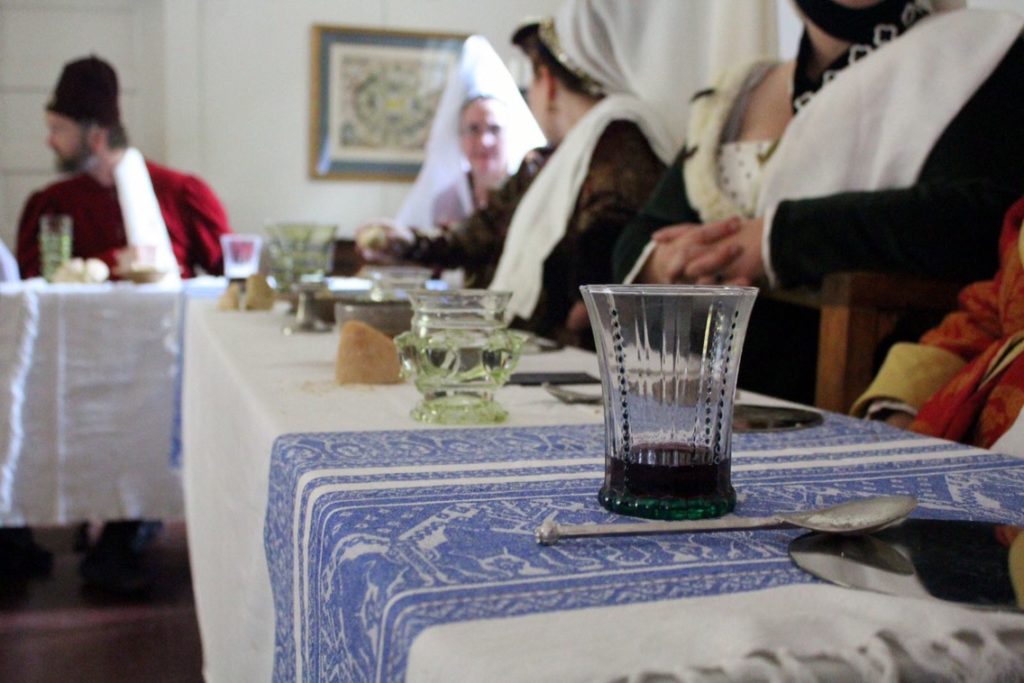
The other flanking table during a pause between courses. © Compass Star Photography. Used with permission.
Each dish was brought out, served, and then cleared before the next one came (the sauces came out with the meats they were paired with). The serving staff lined up with the marshal of the hall and carvers at the front followed by the servers. They came forward, bowed with bowls in hand, and then split off to serve their assigned tables. The server at my table, Viscount Leohtulf of the Silver Hills, did a great job of seeing to our needs. He served the food onto our plates for us so that we didn’t have to pass bowls around, and he ensured that the butler (the server in charge of beverages) made regular visits to keep our glasses full.
For easy of service, most of the food had been cut into small pieces in the kitchen before it was sent out. But the roast goose was presented whole to the high table, and Paul and Master Klaus Rother von Schweinichen, the two carvers, had the task of breaking it into bits small enough that we could politely eat it with our fingers. It was like carving a tricky Thanksgiving turkey in front of a bunch of people while trying not to make a mess. They did a good job, but I’m glad I wasn’t assigned that task.
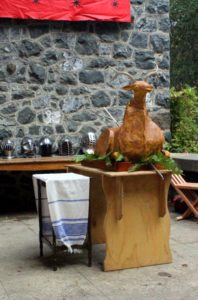
The Stag. © Compass Star Photography. Used with permission.
Throughout the entire meal, we were treated to music played by Mistress Elizabeth of Dendermond. She was joined by Sir Gaston de Clermont when he had a break in his duties as a server.
In addition to the ongoing musical entertainment, there were several interludes which broke the meal into courses. At one point, the hosts, marshal of the hall, and several guests entertained everyone with stately dances. At another point, the almoner returned to perform the legend of St. Martin of Tours’ cloak. But the most spectacular interlude was the stag. A large “pastry” stag was placed in front of the high table. It was dramatically speared, and where the spear pierced it, wine flowed out into a basin.
Service during the late medieval time period is different than our Victorian-influenced view. The servers were of social standing just below the people they served. Rather than being silent and unseen, they interacted with diners, using the time to build social capital. We didn’t necessarily engage in as much conversation with our servers as would have been appropriate historically, but we did get in to some fun discussions. A few of the others sitting at the flanking tables also really enjoyed having the page and servers deliver messages for them. The antics when those were “accidentally” mis-delivered added to the fun.
I don’t know how long the meal lasted, but apparently we went over the time scheduled. The closing rituals of the meal were cut short a bit in the interest of transitioning to the tournament before it got dark. While I was saddened that we skipped almost everything other than the closing grace (again in Latin), I understood the decision to move on to the pas d’armes. For this event, the fighters in the tournament were required to be servers in the feast hall, so everyone wanted to be sure that their work as servers was rewarded. And, we knew the pas would be fun to watch.

Paul’s goose crest.
One aspect of the tournament described in Rene d’Anjou’s c. 1460 Book of the Tournament was a showcase of crests. On the day before a large tournament, combatants would display their helms adorned with elaborate heraldic crests. Paul decided to embrace this idea and made a goose-shaped crest for his helm. The goose was in honor of St. Martin of Tours since the goose is one of the emblems of that saint. Historical crests were often made with leather and were worn while fighting. Paul’s is more fragile, so it was only used during the display of the helms before the meal.
There were ten combatants, divided into two teams, tenans and venans. The combatants were introduced and then each of the venans got to challenge one of the tenans. The fighters thrilled us with their skill at arms, wielding a wide variety of weapons forms. These challenges continued for several rounds, sometimes pairing one-on-one, other times two-on-two. As in other similar tournaments I’ve witnessed, combat at the barrier is always especially exciting to watch. I had fun chatting with other guests while watching Paul’s fights. The view from the second story of the Stone House was fantastic. I can see why there are so many historical depictions of tournaments where the gallery is on an elevated platform.
The guests were a bit more relaxed as we wandered around, vying for good spots to watch from. Vyncent and several others brought a table up to the gallery and were playing historical card games with those who wanted a break from watching the combat. Occasionally, they’d jump up from the card table, run to the edge of the balcony, and wager on the combat. Of course, the wagers were negotiated in hand-struck replicas of historical coins.

Tournament field.
The tournament ended with a two-on-two resurrection battle. Two fighters from each side battled across the barrier. As a fighter was struck, he would step back and be replaced by another member of his team. He would then go to the back of the line and wait until a space opened at the barrier to be filled. This meant we got to see dynamic, continuous fighting for about five to ten minutes as dusk overtook the field. The fighters were tired. The guests were satisfied. It was a good way to end the main events of the day.
After the tournament, the guests who were not staying overnight started to filter out, heading towards cars for their journey back to the modern world. The rest of us enjoyed time chatting by candle light. The lady of the house gave awards to several of the fighters for personifying chivalric virtues in the tournament, and Paul was recognized for franchise.
The kitchen staff set out a buffet supper of the leftovers from the feast. Since the feast had been cut a little bit short, supper included a few things that hadn’t made it out to the tables in time: savory meatballs and sweet wafers with jam. None of us were especially hungry, but the food was so good we couldn’t pass it by. We nibbled a bit here and there until contented exhaustion overcame us.
The next morning, I woke up with the sun and helped to take down decorations and move the original furniture back into the building. By the time we were done, the building was no longer a medieval manor house and was once again a Girl Scout camp. It was amazing how the individual pieces had come together to transport us all so thoroughly to a different time and place.
The next Perfectly Period Feast that’s been announced will be in An Tir in the fall of 2019. I’m already excited to try and be a part of that one, too.
One wonderful choice made by the event staff was to have a dedicated photographer, Compass Star Photography. This almost eliminated people pulling out cell phones to capture pictures. There were the occasional pictures taken sneakily while everyone was getting ready, but I didn’t see any phones break the atmosphere during the feast itself. The only down side is that I’m having to be very patient and wait for her to process the thousands of images she took. {Update: pictures are now available! I’ve added links throughout to appropriate images, but I highly recommend looking through all of them.}
